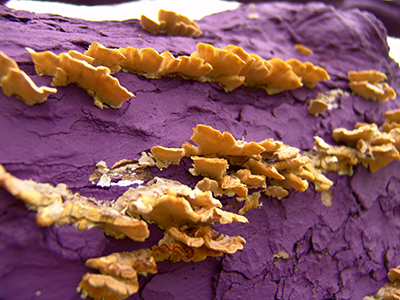Lifecycles: Trametes versicolor
 Over the years the Arboretum has created various forms of ephemeral art using dead or dying trees (In the Shadow of Abracadabra or Bender oak sculpture.) These efforts bring attention to the complete lifecycle of trees and plants as they age and pass in landscape. The latest addition, Tsuga canadensis Pendula Purpurea, is currently showcasing how even in death a tree supports many forms of life.
Over the years the Arboretum has created various forms of ephemeral art using dead or dying trees (In the Shadow of Abracadabra or Bender oak sculpture.) These efforts bring attention to the complete lifecycle of trees and plants as they age and pass in landscape. The latest addition, Tsuga canadensis Pendula Purpurea, is currently showcasing how even in death a tree supports many forms of life.

John Bickel, assistant horticulturist, spray painting the large branches of Tsuga canadensis ‘Pendula’. photo credit: R. Robert
Last spring Josh Coceano, horticulturist, and John Bickel, assistant horticulturist, painted the deceased Tsuga canadensis ‘Pendula’ a vibrant purple to highlight the beautiful structure of this weeping tree. This season the vibrant purple is decorated with stripes of white.
These stripes are rows of Trametes versicolor or turkey-tails. Turkey-tails are wood-decaying polypore mushrooms that grow on virtually any type of wood. Most wood-decaying fungi are specialists, either softwoods or hardwoods, but not both.

This season the vibrant purple is decorated with stripes of white turkey-tails. photo credit: R. Robert
Called “guardians of the forest” by Paul Stamets, a dedicated mycologist, they are the most common mushroom in the world, found across various temperature climates. Turkey-tails are typically the first fungi to form, paving the way for further fungi and microbial succession.

Ephemeral art of dead and dying trees brings attention to the complete lifecycle of trees as they age and pass in landscape. photo credit: R. Robert
With their fan-shape, it is easy to see why people call them turkey tails. Their color is affected by the mineral content of the wood they are decaying. This coloration can be used to make blue and green dyes for wool and other fabrics.

Tsuga canadensis Pendula Purpurea underplanted with Tulipa ‘Prinses Irene’ this spring. photo credit: R. Robert
Stop by the “purple tree” as it takes on second life through fungi.






No Comments